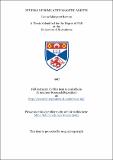Studies of some antiparasitic agents
Abstract
Each year, between 300 and 500 million people develop malaria. Close to 3 million people die as a result. Due to resistance there are now few drugs left which are effective against malaria; one is a Chinese herbal remedy called qinghaosu (artemisinin). A section of this thesis represents an attempt to understand further the mode of action of this antimalarial agent. Several mechanisms involving iron have been proposed and the main categories reviewed (chapter 3). Techniques including ESR spectrometry, fluorescence and absorbance measurements were used to further probe the mode of action of qinghaosu. The findings of these studies provide support for a mechanism proposed by Wu et al., involving cleavage of the peroxy bridge in qinghaosu with the ferrous ion as opposed to antimalarial activity being due to the generation of high valent iron-oxo species. The ether derivative of qinghaosu, arteether has been studied using 2D NMR in order to provide further insight into the unusual structure of this compound (chapter 4). A comparison of the sp2 lactone functionality in qinghaosu with the sp3 ether group in arteether was performed. Evidence is presented for different conformations and chemical shift values. The immune system protects the human body from invasion by foreign substances or cells. A key part of this immune response comes from cellular components known as macrophages. The killing process of macrophages appears to involve nitric oxide. However, this natural defence mechanism is not very efficient as the body is susceptible to invasion by microbes. The term microbe includes both parasites and bacteria. The toxicity of nitric oxide (NO) and NO donor compounds has been investigated using the bacterium E. coli (chapter 5). In addition, studies have been performed using parasites. Malarial parasites (Plasmodia) are difficult to culture, therefore Leishmania parasites which cause the tropical disease leishmaniasis were used as a model (chapter 6). Evidence is presented for the toxic nature of NO donor compounds towards both parasites and bacteria. However, qinghaosu and its derivatives did not prove effective against Leishmania mexicana parasites in contrast with their reported antimalarial activity. The conclusions of this study suggest that qinghaosu possesses a toxicity mechanism selective for malarial parasites.
Type
Thesis, PhD Doctor of Philosophy
Collections
Items in the St Andrews Research Repository are protected by copyright, with all rights reserved, unless otherwise indicated.

